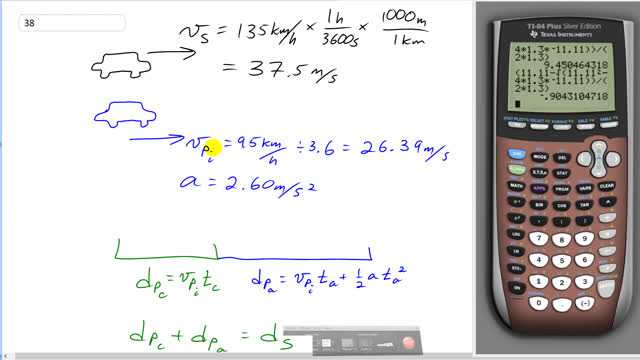
An unmarked police car traveling a constant 95 km/h is passed by a speeder traveling 135 km/h. Precisely 1.00 s after the speeder passes, the police officer steps on the accelerator; if the police car's acceleration is , how much time passes before the police car overtakes the speeder (assumed moving at constant speed)?

In order to watch this solution you need to have a subscription.
This is Giancoli Answers with Mr. Dychko. This speeder passes the police car at a speed of 37.5 meters per second after we convert to kilometers per hour and the speed of the police car initially is 26.39 meters per second; police car has an acceleration of 2.6 meters per second squared and the distance that the police car travels and it will be the same as the total distance traveled by the speeder once he catches up and there's two portions of the police car strip though; one portion where he's going at constant speed before he steps on the accelerator and then another portion after he starts accelerating and they are given by different formulas. The distance that this speeder travels is, you know, he's going at constant speed and he travels for the total time that the police car spends trying to catch up which consists of time that he spends going at constant speed which we are told is 1 second plus some unknown time that he spends accelerating; this time is what we'll have to solve for and then we'll add 1 second to that to get the total time for the police car to catch up. So we have substituting for d s in this formula and rewriting that down here, we have that the police car distance traveled when it's going at constant speed plus the distance traveled for the police car when it's accelerating equals the speed of the speeder times the total time. And then we are gonna mix a whole bunch of substitutions here when the police car is going at constant speed, its distance will be the initial velocity of the police car multiplied by the time that it spends going at constant speed which is 1 second and then we'll add to that the distance that it travels while accelerating. And then expanding this bracket here, we have v s times t c plus v s times t a and then collecting all the terms on the left side, this is gonna end up being a quadratic equation that we have to solve for using this formula. When we bring the v st c term to the left, it's gonna have a minus v st c and then we can factor out the common factor t c from this term and that term giving us v P i minus v s both times t c and then when this term goes to the left side, it combines with v P i minus v s are in brackets multiplied by this common factor t a that those two terms have and then we substitute for all these letters here; acceleration of the police car is 2.6 meters per second squared and the initial speed of the police car 26.39 meters per second and then here's the speed of the speeder and then times by the unknown t a plus the difference in the speeds times 1 second and this gives 1.3t a squared minus 11.11 times t a minus 11.11 equals 0 and we'll use the quadratic formula to solve for that and you use a plus sign to get a positive answer and when you use a minus sign in the quadratic equation, you get a negative answer which is nonsensical so we'll just go with 9.45 seconds and add to that the time that the police car spends going at constant speed, which is 1 second, for a total time of 10.45 seconds for the police car to catch up to the speeder.